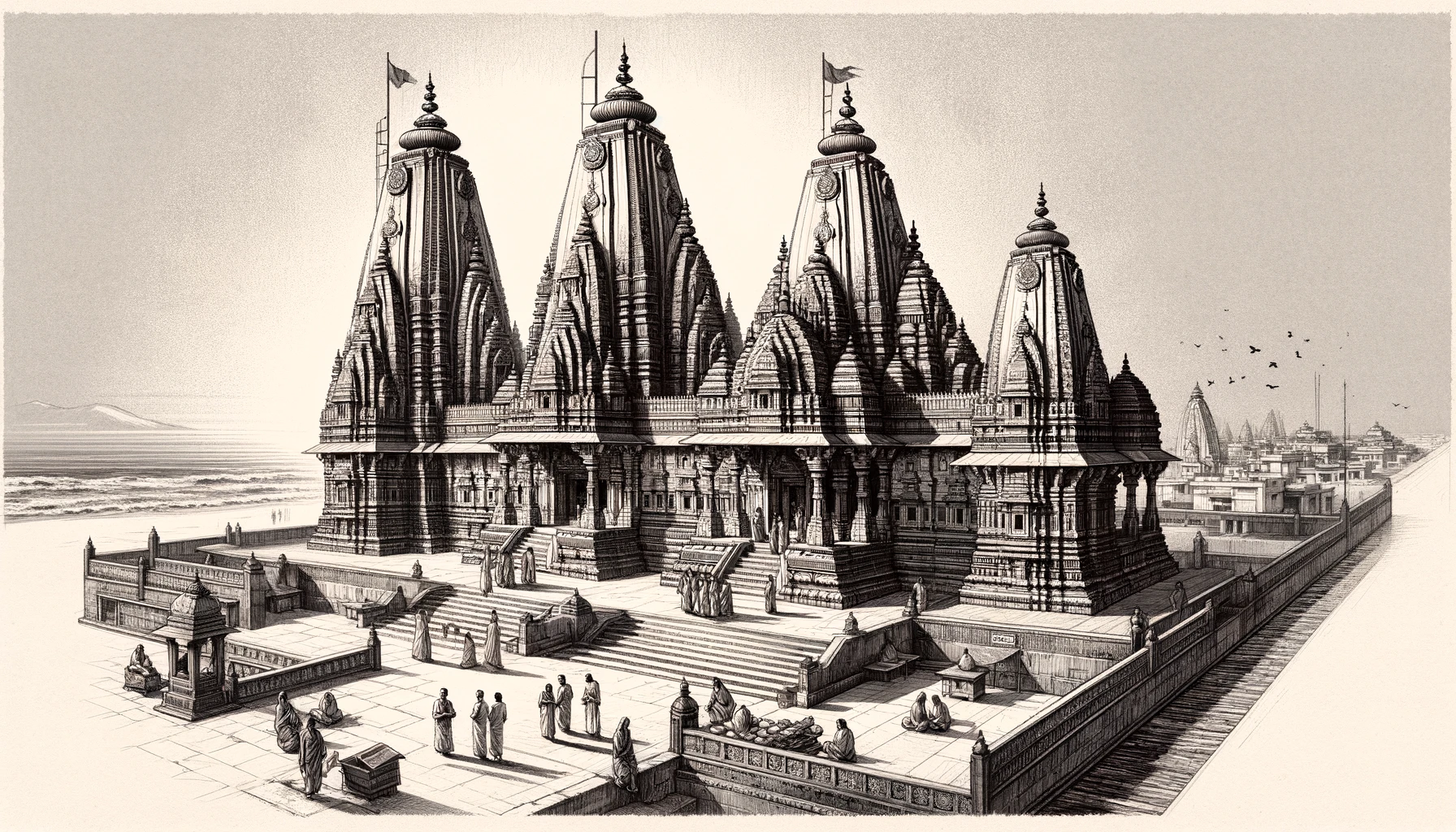Introduction:
Embark on a spiritual odyssey to Somnath, where legends breathe and faith is etched in stone. This sacred temple, revered as the first Jyotirlinga of Lord Shiva, captures the essence of divine resilience and spiritual purity. Situated at the western coast of Gujarat, Somnath Temple is not just a destination but a celestial journey that has attracted pilgrims through millennia.
Spiritual Essence of Somnath:
The lore of Somnath is as captivating as its spiritual aura. The temple’s deity, Lord Shiva as Somnath, signifies the protector of the Moon God, showcasing the deep cosmic connections and the profound spiritual ideologies that Indian mythology harbors. The Jyotirlinga itself is a symbol of primordial light, offering devotees a beacon of divine guidance and enlightenment.
Architectural Majesty and Reconstructions:
The architectural narrative of Somnath is a chronicle of rebirth and remarkable resilience. With each reconstruction, the temple has mirrored the changing dynasties and architectural styles, from the intricate designs of the early structures to the contemporary Chalukya style that defines the current edifice. The temple’s design, with its imposing shikhara, intricate carvings, and the sanctum that houses the luminous Jyotirlinga, stands as a testament to India’s architectural evolution and devotion.
The Pilgrim’s Path:
A visit to Somnath transcends conventional pilgrimage. It is an immersion into a vibrant tapestry of faith, where the sounds of the ocean and the serene ambiance of the temple compound elevate the spiritual experience. The rituals and ceremonies, particularly the mesmerizing aarti and the serene darshan, connect the devotee to the divine, offering a profound sense of peace and divinity.
The Historical Saga of Somnath
The history of Somnath Temple is as dramatic and enduring as the legends that surround it. Believed to have been originally built in gold by the moon god Soma, in silver by the sun god Ravi, in wood by Krishna, and in stone by the Solanki Rajputs in the 11th century, the temple’s architectural evolution is a mirror to India’s religious and political transformations over centuries.
Archaeological and Historical Significance:
The archaeological excavations around Somnath have unearthed evidence suggesting the presence of earlier temple structures dating back to ancient times, further solidifying its importance in India’s spiritual and cultural heritage. These findings, along with historical records, offer a glimpse into the temple’s architectural evolution and the devotion it has inspired through the ages.
Ancient Origins and Mythological Foundations:
The origins of Somnath are shrouded in myth and legend, with references found in ancient texts like the Rig Veda, indicating its significance as a pilgrimage site for thousands of years. The temple’s lore is intertwined with that of the moon god, who was cured of illness by Shiva’s grace here, thus granting the site its name, Somnath, or ‘Lord of the Soma’.
A Target of Invasions:
Somnath’s splendor and wealth attracted the attention of numerous invaders over the millennia. The most notable of these invasions occurred in 1026, when Mahmud of Ghazni sacked the temple, purportedly carting away loads of gold and silver. This event marked the beginning of a series of invasions and destructions that the temple would endure at the hands of different conquerors.
Resilience Through Reconstruction:
Despite being destroyed and desecrated multiple times, the temple always found patrons in India’s devout and its rulers, who rebuilt it each time, a testament to the unyielding spirit of faith and resilience of the Indian people. The final reconstruction, initiated by Sardar Vallabhbhai Patel after India’s independence, restored the temple to its current grandeur in 1951, symbolizing the nation’s revival and spiritual resilience.
Accordion title 1
This is a placeholder tab content. It is important to have the necessary information in the block, but at this stage, it is just a placeholder to help you visualise how the content is displayed. Feel free to edit this with your actual content.
Accordion title 2
This is a placeholder tab content. It is important to have the necessary information in the block, but at this stage, it is just a placeholder to help you visualise how the content is displayed. Feel free to edit this with your actual content.
Modern-Day Somnath:
Today, the Somnath Temple not only stands as a symbol of Hindu faith and perseverance but also as a beacon of national pride and cultural identity. It draws millions of pilgrims and tourists from across the world, eager to witness its beauty and partake in its storied history.
Cultural and Festival Celebrations:
Somnath Temple is the epicenter of spiritual and cultural festivities, with Mahashivratri being the pinnacle of celebration. The temple complex comes alive with devotional music, traditional dances, and thousands of pilgrims congregating to witness the divine marriage of Lord Shiva and Goddess Parvati. The festival not only showcases the rich cultural heritage of Gujarat but also the universal themes of devotion and celebration that resonate across India.
The Somnath Experience:
Beyond the spiritual, Somnath offers a holistic experience that encompasses serene beach views, historical explorations, and the warmth of a community bound by faith. The temple’s location at the confluence of three holy rivers and the Arabian Sea adds a natural splendor to the pilgrimage, making it a journey of both inner peace and outer beauty.
Conclusion:
The Somnath Temple, with its storied past, spiritual gravity, and architectural splendor, continues to stand as a beacon of eternal faith. It invites not just the devout but anyone seeking to experience the confluence of divine energy, historical resilience, and the timeless beauty of devotion. As we tread the sacred grounds of Somnath, we walk in the footsteps of countless pilgrims, sharing in the light of faith that has illuminated this holy site for centuries.
